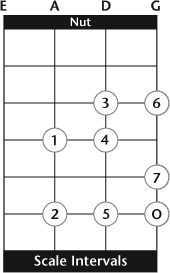| Online Bass Instruction with Rusty Springfield | ||
 |
||
|
Home | eMail | Articles | Audio Clips | Bass Gallery
Great Bass Tales | Photo Archive | Links | Lessons |
||
| Intervals |
|
||
It would benefit you greatly to have a working knowledge of the keyboard. There are many books on the subject of theory as it pertains to bass. One good one is Chuck Rainey's The Complete Electric Bass Player, Book 1, The Method. It's published by Amsco Publications, and costs about $20. Well worth it!
When we talk about the notes in a musical scale, we define them by giving them numbers, for easy identification. For instance, in a C major scale, the first note, also known as the,"root" or "tonic" is C. It is called the "one," and defines the key as "C."
The second note in this scale is a D. It is one whole step above the root.
The third note is E and in the key of C, it is called the third. More specifically, it is called the "major third." By definition, a major third interval is two whole steps above the root. The "third" in a scale or chord is what determines whether that scale or chord is major or minor. If you lower or "flat" a major third by one half step, you have a minor third. If a chord has no third, (and some chords do not) it is really neither major nor minor.
Let's continue with the remaining intervals in our scale. The next note in a C major scale is F. It's called the fourth. More specifically, a "perfect fourth," meaning that it's not altered in any way.
If we move up another whole step, we come to G, which is the perfect fifth in the key of C. Bass lines in many different styles of music incorporate a pattern involving the root and fifth. The fifth interval always sounds like it wants to resolve to the root. One reason that the root/fifth relationship is so popular is that the patterns using them can work over major or minor chords. In addition, it is a mainstay in the "1-5-octave" chord structure of the ever popular "power" chord that has dominated rock & roll guitar for the past quarter century.
Next, we come to the sixth degree of the scale, which is one whole step above the fifth. In the key of C, this note is an A.
One more whole step above the sixth, we encounter the seventh degree of the scale. In the key of C, this is a B. It is also referred to as the "natural" seventh. Notice that in any major scale, the seventh degree is just one half step below the octave of the root. This realization will help you quickly identify the natural seventh in any key.
Notice that there is a pattern of interval placement in any major scale. Counting up from the root of any major key, we derive an interval pattern of: whole step, whole step, half step, whole step, whole step, whole step, half step. The distances between the 1-2-3-4-5-6-7-octave in a major scale give that scale it's unique "major" sound.
By the way, the major scale has another name, which is used in music schools, but not often in the "real" world. It's called the Ionian Mode. (Whooo!)
As a serious bassist, you must be able to instantly recall and identify any interval in any key. This isn't quite as daunting as it sounds. Once you have memorized the major scale pattern on your bass, you can mentally move it to any new key position and quickly find whichever interval you're looking for.
Quick! What's the 6th degree in the key of B major? (Made you think!)
| Go to the next lesson: Scale Fingering |
